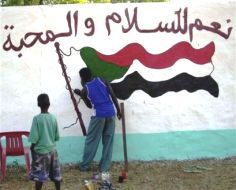A year after, Sudan peace still fragile
Jan 8, 2005 (KHARTOUM) — A year after it was signed, Sudan’s Coprehensive Peace Agreement that ended more than two decades of war has overcome several obstacles but is still threatened on several fronts, analysts say.
 A north reluctant to loosen its grip on power, a south already leaning towards independence, other conflicts in the west and east and a lack of international commitment are only some of the perils the agreement faces.
A north reluctant to loosen its grip on power, a south already leaning towards independence, other conflicts in the west and east and a lack of international commitment are only some of the perils the agreement faces.
On January 9, 2005, Sudanese Islamist regime and the mainly southern rebels signed a peace deal that put an end to a war that lasted 21 years, killed 1.5 million people and displaced four million.
“There have been some achievements in the implementation of the deal: its key institutions have been set up despite delays and its main actors have managed to avoid major divisions so far,” analyst Mohamed Mahjoub Haroun said.
“But there is still a long way to go to develop a political culture and move away from the context of war,” said Haroun, who heads an independent Sudanese think tank.
Joint commissions have been created and a national unity
government including the ruling National Congress and the former rebels of the Sudan People’s Liberation Movement was sworn in on September 22.
But the fledgling peace agreement still faces sporadic violence and the huge challenges of reconstruction, mine-clearance and mass repatriation.
“One of the most worrisome things is the systematic effort on the part of the National Congress party to delay the implementation of the agreement,” said analyst David Mozersky, from the International Crisis Group (ICG).
Beshir, who seized power in a 1989 military coup, has a tiny support base and has to open up the political arena to competition and relinquish any control on the country’s oil bounty.
“The facade of shared governance masks the ruthless preservation of power by the” Islamic regime, US-based Sudan analyst Eric Reeves wrote in a recent commentary.
But the SPLM’s contribution to the momentum of the peace deal has also fallen short of expectations.
“The south is more worried about its future independence than preserving a united Sudan,” Haroun, of The Future Trends Foundation for Strategic Studies and Dialogue, based in Khartoum, said.
He was referring to a referendum on self-determination due to be held in six years.
The death of the SPLM’s historical leader John Garang in a July helicopter crash also dealt a serious blow to a peace process he had come to symbolise.
The lack of charisma and credibility of his successor Salva Kiir has left the SPLM’s different factions struggling to outline a clear vision and oversee its metamorphosis from a rebel group to ruling political party.
Ongoing civil strife in the western region of Darfur and the looming threat of a conflagration in the eastern provinces have also contributed to the fragility of the north-south peace deal.
In a report released this week on the so-called eastern front, ICG deplored that the January 9 deal did not seek to defuse these other powder kegs.
“Maybe Darfur and the East should be brought within the
framework of the Comprehensive Peace Agreement,” Haroun said.
But analysts also blamed the international community for failing to stand by its commitments and letting Africa’s largest country run the risk of sinking back into conflict.
Mozersky took to task foreign powers for their “lack of visible engagement to be the guarantors of the peace process.”
The African Union, which deployed close to 7,000 troops in
Darfur in 2005, took much flak for failing to stabilise the area, where an estimated 300,000 people have died and 2.4 million been displaced.
“But the UN Security Council fell short by passing resolutions and holding nobody accountable. The US labeled Darfur a genocide but then did very little about it,” Mozersky argued.
